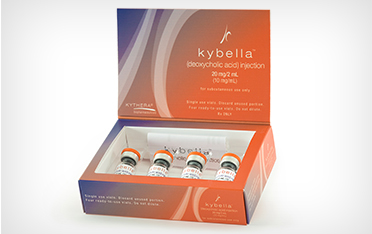Kybella, or deoxycholic acid, is a new fat-dissolving, injectable drug used to treat double chin. “Kybella was introduced in the United States this past summer,” says Dr. Adam Mamelak, board certified dermatologist and cosmetic specialist in Austin, Texas. Currently, the gold standard for this procedure is liposuction. Will this new trend stand the test of time and replace liposuction as the preferred treatment of physicians and patients? Here is a list of the pros and cons of Kybella vs. liposuction for comparison.
 Advantages of Kybella
Advantages of Kybella
No downtime — since this is an injectable drug, there really is no downtime associated with it after the procedure. “We’re literally treating patients with Kybella over their lunch hour, and having them go back to work right after the treatment,” says Dr. Mamelak. Some patients spend a little time icing the area to prevent bruising and swelling the following day.
No anesthesia — patients are not put to sleep for this procedure. The only anesthesia that is advisable is either a local or topical one for maximal comfort.
Disadvantages of Kybella
Will not correct neck bands — if you have this condition, Kybella is not the right treatment for you. “Neck bands actually represent muscles in the neck that can become more prominent with age,” says Dr. Mamelak. “Although Botox injections can eliminate these bands, they actually require a surgical neck lift to fix permanently.” Because Kybella and liposuction remove the fat under the chin and do not treat muscles, neither approach would be a recommended treatment for neck bands.”
May make neck liposuction more difficult in the future — the long-term effects of fat-dissolving is not clear at this time. Kybella might promote the formation of scar tissue making liposuction more difficult.
Advantages of Liposuction
Liposuction like liposuction in San Antonio, TX uses suction to remove fat from specific areas of the body, such as the stomach, hips, thighs, buttocks, arms or neck. Liposuction also shapes these areas.
Produces more dramatic results — “Fat reduction with Kybella occurs over a series of treatments, usually spaced anywhere from 4 to 6 weeks apart,” explains Dr. Mamelak. With liposuction, all of the fatty tissue is removed in one sitting. Since the physician evaluates the fat reduction during the procedure, he can customize your treatment in real time.
Requires very little downtime — while it is recommended that you take a couple of days off work, the procedure can be done on a Thursday or Friday with recovery time over the weekend. It is usually recommended to wear a compression bandage or neck sling for 1 or more following liposuction.
Disadvantages of Liposuction
Anesthesia recommended — while the risk of this type of anesthesia is no greater than having a colonoscopy or wisdom teeth removed, liposuction is still considered a surgical procedure. Although low, the risks of anesthesia are present, along with bleeding, pain, infection and other potential adverse outcomes that occur with surgery.
Cost — “Cost gets a lot of attention when comparing Kybella to liposuction,” says Dr. Mamelak. While many question the cost of Kybella, it is important to note that liposuction can accrue additional expense, especially if more equipment or personnel are required, or if the procedure if performed in an operating room or surgery center.
Kybella was just recently approved by the FDA for submental fat reduction, or double chin treatment in 2015. While there are pros and cons to both procedures, discuss these with your physician before making the decision on which treatment is the best for you.

